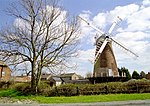The Hoo, Willingdon and Jevington
Gardens by Gertrude JekyllGrade I listed buildings in East SussexGrade I listed housesHouses completed in 1902Use British English from December 2023 ... and 2 more
Wealden DistrictWorks of Edwin Lutyens in England

The Hoo is an Neoclassical country house in Willingdon, in the Wealden district of East Sussex, England. It was designed by Edwin Lutyens in 1902 for Alexander Wedderburn, a wealthy lawyer. Considered one of Lutyens' best houses, it is a Grade I listed building. The gardens, which had input from Gertrude Jekyll, are designated at Grade II* on the Register of Historic Parks and Gardens of Special Historic Interest in England.
Excerpt from the Wikipedia article The Hoo, Willingdon and Jevington (License: CC BY-SA 3.0, Authors, Images).The Hoo, Willingdon and Jevington
Church Street, Wealden Willingdon and Jevington
Geographical coordinates (GPS) Address Nearby Places Show on map
Geographical coordinates (GPS)
| Latitude | Longitude |
|---|---|
| N 50.799166666667 ° | E 0.25333333333333 ° |
Address
Thai Village
Church Street 29c
BN20 9HR Wealden, Willingdon and Jevington
England, United Kingdom
Open on Google Maps






